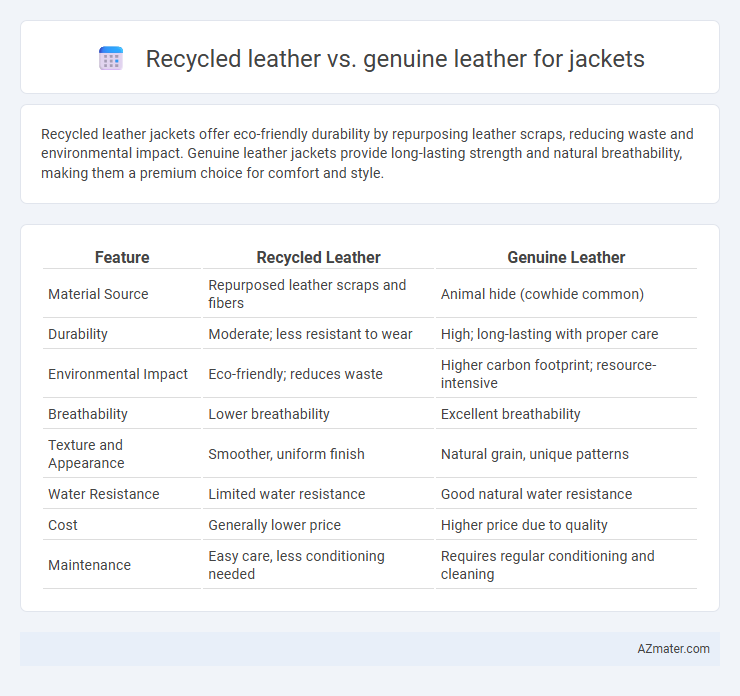Recycled leather jackets offer eco-friendly durability by repurposing leather scraps, reducing waste and environmental impact. Genuine leather jackets provide long-lasting strength and natural breathability, making them a premium choice for comfort and style.
Table of Comparison
| Feature | Recycled Leather | Genuine Leather |
|---|---|---|
| Material Source | Repurposed leather scraps and fibers | Animal hide (cowhide common) |
| Durability | Moderate; less resistant to wear | High; long-lasting with proper care |
| Environmental Impact | Eco-friendly; reduces waste | Higher carbon footprint; resource-intensive |
| Breathability | Lower breathability | Excellent breathability |
| Texture and Appearance | Smoother, uniform finish | Natural grain, unique patterns |
| Water Resistance | Limited water resistance | Good natural water resistance |
| Cost | Generally lower price | Higher price due to quality |
| Maintenance | Easy care, less conditioning needed | Requires regular conditioning and cleaning |
Introduction: Why Compare Recycled and Genuine Leather Jackets?
Recycled leather and genuine leather jackets offer distinct benefits in terms of sustainability, durability, and texture, making comparison essential for eco-conscious consumers. Recycled leather reduces environmental impact by repurposing leather scraps, whereas genuine leather provides traditional quality and longevity due to its natural fibers. Understanding these differences helps buyers choose jackets that align with their values and performance expectations.
What is Recycled Leather?
Recycled leather is created by reprocessing leather scraps and offcuts, which are shredded and bonded with a polyurethane or latex binder to form new leather sheets. This sustainable material retains the look and feel of genuine leather while reducing waste from leather manufacturing processes. Jackets made from recycled leather offer an eco-friendly alternative without compromising durability or style.
What is Genuine Leather?
Genuine leather is made from the natural hide of animals, primarily cows, which undergoes a tanning process to enhance durability and maintain its authentic texture and breathability. It offers superior strength, aging characteristics, and a unique patina that develops over time, making it highly valued for jackets. Compared to recycled leather, genuine leather provides better resistance to wear and a more luxurious feel, ensuring long-lasting quality and comfort.
Sustainability and Environmental Impact
Recycled leather jackets reduce waste by repurposing leather scraps, minimizing landfill contribution and lowering resource consumption compared to genuine leather production. Genuine leather requires intensive water use, chemical treatments, and livestock farming, which significantly increase greenhouse gas emissions and environmental degradation. Choosing recycled leather supports circular fashion practices and helps lessen the ecological footprint associated with traditional leather manufacturing.
Durability and Longevity
Recycled leather jackets offer moderate durability but tend to wear out faster than genuine leather due to their composite material composition. Genuine leather is prized for its superior strength and ability to develop a rich patina over time, enhancing both longevity and aesthetic appeal. Investing in genuine leather ensures a jacket that withstands daily wear and ages gracefully, often lasting decades with proper care.
Look, Feel, and Style Comparison
Recycled leather jackets offer a unique, textured appearance with a slightly less uniform surface compared to genuine leather, which boasts a smooth and natural grain that ages beautifully over time. The feel of recycled leather is often softer and more pliable due to its composite nature, while genuine leather provides a sturdy, durable touch with enhanced breathability. Style-wise, genuine leather jackets convey a classic, timeless elegance favored in high-end fashion, whereas recycled leather appeals to eco-conscious consumers looking for sustainable yet stylish alternatives.
Cost Differences
Recycled leather jackets typically cost 20-40% less than genuine leather due to lower raw material expenses and simpler manufacturing processes. Genuine leather requires animal hides and extensive tanning, contributing to higher prices often ranging from $200 to over $1000 per jacket. The cost difference also reflects durability and quality variations, with recycled leather offering a budget-friendly, eco-conscious alternative but generally shorter lifespan.
Maintenance and Care Requirements
Recycled leather jackets generally require less intensive maintenance compared to genuine leather, as they resist cracking and fading but may be less breathable, necessitating careful conditioning with specific synthetic leather cleaners. Genuine leather jackets demand regular conditioning with natural leather oils to maintain suppleness and prevent drying or cracking, along with protection from excessive moisture and direct sunlight to preserve their appearance. Both materials benefit from storage in cool, dry environments and occasional cleaning with appropriate, product-specific solutions to extend jacket longevity.
Ethical Considerations
Recycled leather jackets offer an ethical advantage by reducing waste and minimizing the environmental impact associated with traditional leather production, which often involves animal cruelty and intensive resource use. Genuine leather requires the raising and slaughtering of animals, raising concerns about animal rights and greenhouse gas emissions from livestock farming. Choosing recycled leather supports sustainable fashion practices by promoting circularity and reducing the carbon footprint of clothing manufacturing.
Which Jacket Should You Choose?
Recycled leather jackets offer an eco-friendly alternative by utilizing repurposed leather scraps, reducing waste without compromising on style or durability. Genuine leather jackets provide superior longevity, natural breathability, and a unique patina that develops over time, enhancing their aesthetic appeal. Choose recycled leather for sustainability and affordability, or genuine leather for classic quality and durability, depending on your values and usage needs.

Infographic: Recycled leather vs Genuine leather for Jacket
 azmater.com
azmater.com